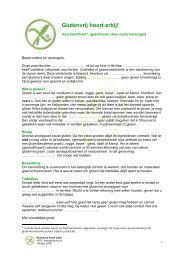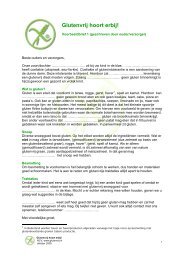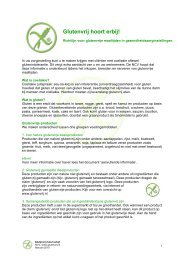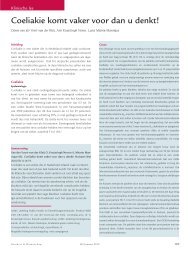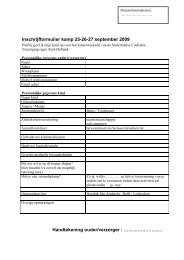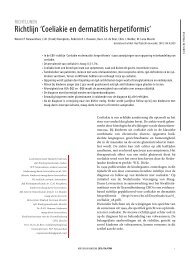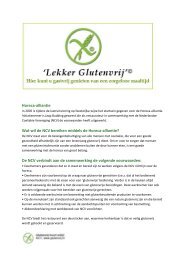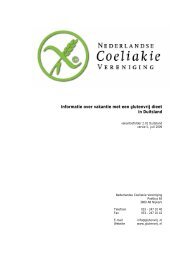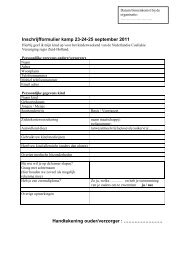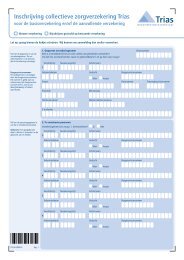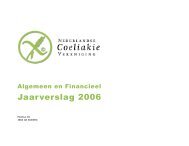Richtlijn Coeliakie en Dermatitis Herpetiformis - Nederlandse ...
Richtlijn Coeliakie en Dermatitis Herpetiformis - Nederlandse ...
Richtlijn Coeliakie en Dermatitis Herpetiformis - Nederlandse ...
You also want an ePaper? Increase the reach of your titles
YUMPU automatically turns print PDFs into web optimized ePapers that Google loves.
• Weile B, Cavell B, Niv<strong>en</strong>ius K, Krasilnikoff PA. Striking differ<strong>en</strong>ces in the incid<strong>en</strong>ce of childhood<br />
celiac disease betwe<strong>en</strong> D<strong>en</strong>mark and Swed<strong>en</strong>: a plausible explanation. J Pediatr Gastro<strong>en</strong>terol<br />
Nutr 1995;21(1):64-8,<br />
• Weile B, Krasilnikoff PA. Extremely low incid<strong>en</strong>ce rates of celiac disease in the Danish<br />
population of childr<strong>en</strong>. J Clin Epidemiol 1993;46(7):661-4.<br />
• Yachha SK. Celiac disease: India on the global map. J Gastro<strong>en</strong>terol Hepatol 2006; 21: 1511-3.<br />
• Zachor DA, Mroczek-Musulman E, Brown P. Preval<strong>en</strong>ce of celiac disease in Down syndrome in<br />
the United States. J Pediatr Gastro<strong>en</strong>terol Nutr 2000;31:275-9.<br />
2.3 Complicaties<br />
Anemie<br />
Vaak is e<strong>en</strong> (onbegrep<strong>en</strong>) anemie de eerste uiting van e<strong>en</strong> coeliakie (Depla 1990; Lombardo<br />
2006). Zo laat Depla (1990) in e<strong>en</strong> studie van drie person<strong>en</strong> zi<strong>en</strong> dat ijzergebrek het <strong>en</strong>ige<br />
symptoom kan zijn voordat de ziekte na jar<strong>en</strong> wordt herk<strong>en</strong>d. Volg<strong>en</strong>s Lombardo (2006)<br />
werd in e<strong>en</strong> studie van 207 person<strong>en</strong> met anemie e<strong>en</strong> hoge preval<strong>en</strong>tie van coeliakie<br />
herk<strong>en</strong>d.<br />
E<strong>en</strong> van de complicaties van coeliakie kan e<strong>en</strong> (onbegrep<strong>en</strong>) anemie zijn.<br />
Niveau 3<br />
C Lombardio 2006; Depla 1990<br />
Lactose intolerantie<br />
Zie dieet.<br />
Maligniteit<strong>en</strong><br />
De associatie coeliakie <strong>en</strong> maligniteit wordt al lang gesuggereerd. Al in 1937 werd<strong>en</strong> zes<br />
patiënt<strong>en</strong> beschrev<strong>en</strong> met e<strong>en</strong> maligne lymfoom van de dunne darm <strong>en</strong> diarree (Fairley <strong>en</strong><br />
Mackie 1937). In 1961 werd gemeld dat intestinale malabsorptie beschouwd moest word<strong>en</strong><br />
als secundair aan het lymfoom doch in 1962 werd<strong>en</strong> vijf patiënt<strong>en</strong> beschrev<strong>en</strong> met dunne<br />
darm lymfoom bij e<strong>en</strong> lang bestaande coeliakie <strong>en</strong> werd gedacht dat coeliakie e<strong>en</strong><br />
premaligne ziekte was (Gough 1962). In deze jar<strong>en</strong> werd verondersteld dat lymfom<strong>en</strong> zeer<br />
frequ<strong>en</strong>t voorkwam<strong>en</strong> bij volwass<strong>en</strong><strong>en</strong> met coeliakie <strong>en</strong> bij 10-20% van h<strong>en</strong> tot de dood<br />
leidd<strong>en</strong>. De term Enteropathie geassocieerde T-cel lymfoom (EATL) werd in 1986<br />
geïntroduceerd (O’Farrelly 1986). Tot op hed<strong>en</strong> is het niet helemaal duidelijk of coeliakie<br />
alle<strong>en</strong> sam<strong>en</strong>hangt met intestinaal lymfoom of dat er ook e<strong>en</strong> verhoogd risico is van T-cel<br />
lymfom<strong>en</strong> buit<strong>en</strong> de dunne darm zoals ook gesuggereerd wordt bij dermatitis herpetiformis<br />
(Leonard 1983 , Sigurgeirsson 1994). Retrospectief onderzoek liet zi<strong>en</strong> dat e<strong>en</strong> glut<strong>en</strong>vrij<br />
dieet het risico op maligniteit mits vroeg g<strong>en</strong>oeg gestart zou kunn<strong>en</strong> verminder<strong>en</strong> <strong>en</strong><br />
voorkom<strong>en</strong> (Holmes 1989).<br />
Onderzoek<strong>en</strong> met betrekking tot maligniteit<strong>en</strong> bij coeliakie zijn niet altijd ev<strong>en</strong> consist<strong>en</strong>t. Er<br />
wordt gekek<strong>en</strong> naar maligniteit<strong>en</strong> bij bek<strong>en</strong>de coeliakiepatiënt<strong>en</strong> maar ook naar niet bek<strong>en</strong>de<br />
coeliakie bij patiënt<strong>en</strong> bij wie e<strong>en</strong> maligniteit geconstateerd is. De meeste series stamm<strong>en</strong> uit<br />
kliniek<strong>en</strong> met e<strong>en</strong> speciale interesse in coeliakie of in maligniteit<strong>en</strong> waarvan bek<strong>en</strong>d is dat ze<br />
meer voorkom<strong>en</strong> bij coeliakie. Duidelijke epidemiologische gegev<strong>en</strong>s zijn er dan ook niet <strong>en</strong><br />
onderzoekersbias is e<strong>en</strong> van de meest voorkom<strong>en</strong>de “confounding factors”.<br />
<strong>Richtlijn</strong> <strong>Coeliakie</strong> <strong>en</strong> <strong>Dermatitis</strong> <strong>Herpetiformis</strong>, 2008 35



